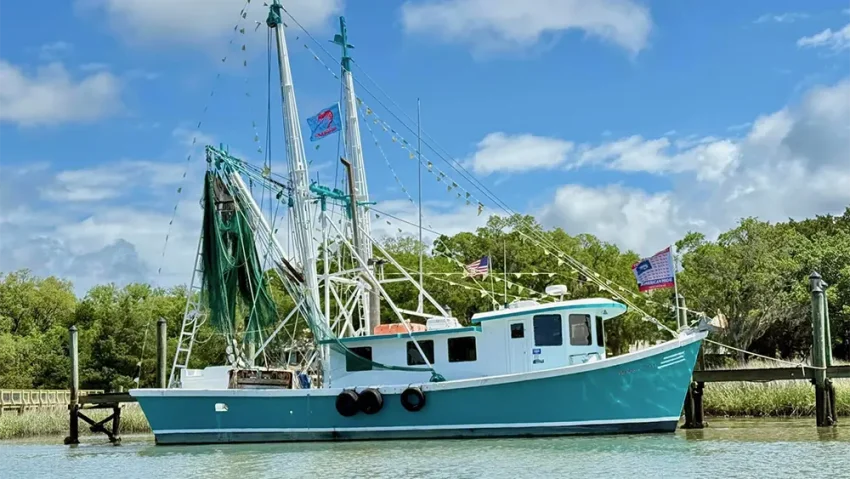
There was a time in the not-so-distant past when the population of Mount Pleasant was lower, but the volume of shrimp boats lining Shem Creek was higher.
Captain Rocky Magwood, a fourth-generation shrimper, remembers a time when shrimp boats were lined up three-to-a-dock up and down the creek, about 80 of them in total. Twenty-five years ago, that number had dwindled to around 70. Today, there are only seven. Seven boats working as hard as possible to keep the local shrimp industry afloat.
With the staggering influx of both residents and tourists, it’s hard to comprehend why the industry our town was once known for – and the fruits of its labor that remain a coveted Lowcountry staple – has contrastingly capsized.
Magwood, president of the South Carolina Shrimper’s Association, and other local shrimpers, are trying to right the ship. They face a mountain of obstacles but have been working at the state and national levels to fight for the lifeblood of their industry, along with fishermen from eight other ‘warm water’ states experiencing similar circumstances.
Running the family business of shrimping doesn’t come easy or cheap, but it’s a labor of love for his family and his community. “We’re all one big breakdown away from being out of business,” Magwood said. “If I didn’t have good friends or people that can help me, I’d already be out of business. Everything we buy to maintain these boats has doubled or quadrupled in price, but we get paid less now for shrimp than we did in 1992 when I started running the boat.”
The demand for local supply has also changed. State waters fluctuate with varying types and sizes of shrimp as the season progresses, and sometimes are abundant with smaller, yet arguably more delicious, brown shrimp. Though the sizes average medium to large, Magwood has noticed that many people who buy shrimp are now looking for size over quality. “Even the large shrimp don’t sell like they used to. Most people now only want jumbo — those just don’t exist here most of the season. If you buy jumbo shrimp, there’s a good chance they’re imported,” he explained.
Whether the change in demand for shrimp size is due to customers not understanding the natural supply of local shrimp or they are just accustomed to the more ‘photogenic’ jumbo shrimp without considering the origins, it has adversely affected sales.
Of the seven boats left, Magwood said that a few will spend part of the season in North Carolina or Florida – where the brown shrimp are slightly larger – and catch and sell their product locally along those shores. For the other boats, they tie up to the dock and end the season, not interested in the small margins produced compared to the effort and money required to fish faraway shores.
Imported shrimp have dealt a significant blow to the local shrimp industry; something that Magwood added is surprising to many people. “If you’re sitting at a restaurant and looking at a shrimp boat as you eat shrimp, don’t just assume the shrimp you’re eating came from here. Ask if they are! Many times, they’re not.”
In June, the results of a genetic testing investigation by SeaD Consulting were released and determined that 90% of the restaurants where shrimp were swabbed had been serving imported shrimp but were deceivingly promoting them as local shrimp through branding, menu descriptions or proximity and view of local shrimp boats. “This is not only deceptive but also insulting to the hardworking shrimpers whose livelihoods are being undermined,” said Erin Williams, founder and COO of SeaD Consulting. “It’s decimating the entire regional economy and culture they’ve worked for generations to build and promote.”
Imported shrimp, Magwood explained, are usually farmed and may contain antibiotics, pesticides and chemicals. “I make sure my customers have the freshest, safest product available. They are American, wild-caught and we just wash them and ice them down,” he said. “Friends don’t let friends eat imported shrimp.”
The best way to help our local shrimping community, he recommended, is to support the shrimpers and the restaurants who truly sell American, wild-caught shrimp. The SC Shrimper’s Association maintains a list of restaurants who serve local, wild-caught South Carolina shrimp on their website at scshrimp.org/our-partners. There is also a QR code with information about buying local shrimp located at the statue of legendary Captain Wayne Magwood on Shem Creek.
Some restaurants not listed on that website may still support the American, wild-caught industry but serve shrimp from other states. SeaD Consulting and those in the shrimp industry are calling for legislation on transparency and labeling, but in the meantime, the firm recommends that consumers not only ask where their shrimp is coming from, but request proof by seeing the box and the words “wild-caught U.S.”
“For those of us still in the shrimping industry, we’re doing it because we love it, not for the money. We’re out there working to support our families and keep our customers happy,” Magwood smiled. “When you love something, you have to fight for it, and that’s what I’m doing. Fighting to help our local shrimp industry thrive again.”
By Anne Toole



Leave a Reply